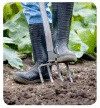Urban gardening: managing the risks of contaminated soil
- PMID: 24284011
- PMCID: PMC3852790
- DOI: 10.1289/ehp.121-A326
Urban gardening: managing the risks of contaminated soil
Figures

Wear gloves, and wash hands after gardening and before eating.
Take care not to track dirt from the garden into the house.
Wash produce before storing or eating, and teach kids to do so, too.
Peel root crops, and remove outer leaves of leafy vegetables.
References
-
- Heiger-Bernays W, et al. Characterization and low-cost remediation of soils contaminated by timbers in community gardens. Int J Soil Sediment Water 235.2009; http://www.ncbi.nlm.nih.gov/pmc/articles/PMC3146259/ - PMC - PubMed
-
- Attanayake CP, et al. Field evaluations on soil plant transfer of lead from an urban garden soil. J Environ Qual; 10.2134/jeq2013.07.0273. [online 25 November 2013]. Available: https://www.agronomy.org/publications/jeq/first-look - DOI - PubMed
-
- EPA. Brownfields and Urban Agriculture: Interim Guidelines for Safe Gardening Practices. Chicago, IL:Region 5 Superfund Division, U.S. Environmental Protection Agency (Summer 2011). Available: http://www.epa.gov/swerosps/bf/urbanag/pdf/bf_urban_ag.pdf [accessed 18 November 2013].
-
- NGA. Garden Market Research: 2013 National Gardening Survey. Williston, VT:National Gardening Association. 2013. Available: http://www.gardenresearch.com/index.php?q=show&id=2369.
Publication types
MeSH terms
Substances
LinkOut - more resources
Full Text Sources
Other Literature Sources

